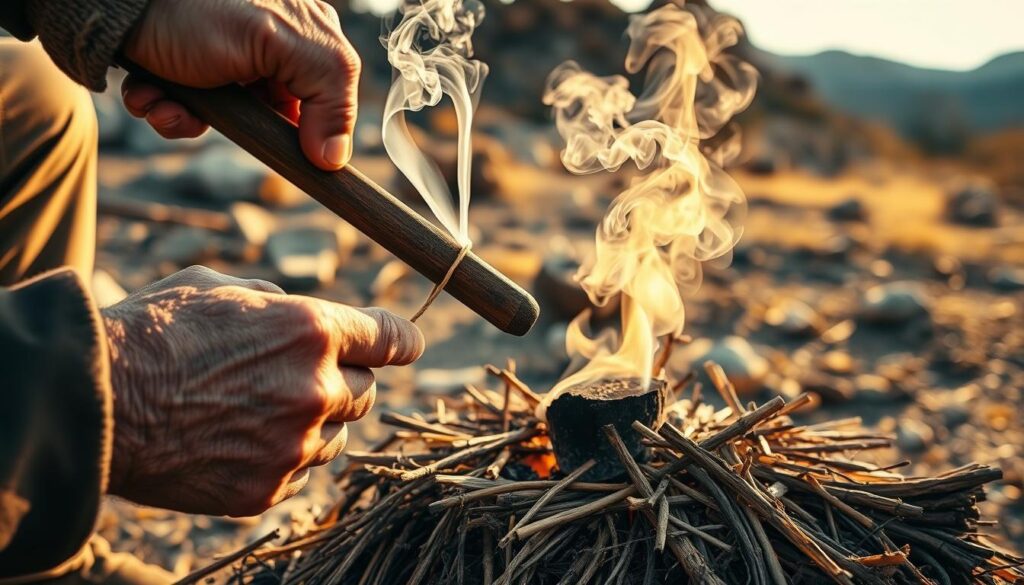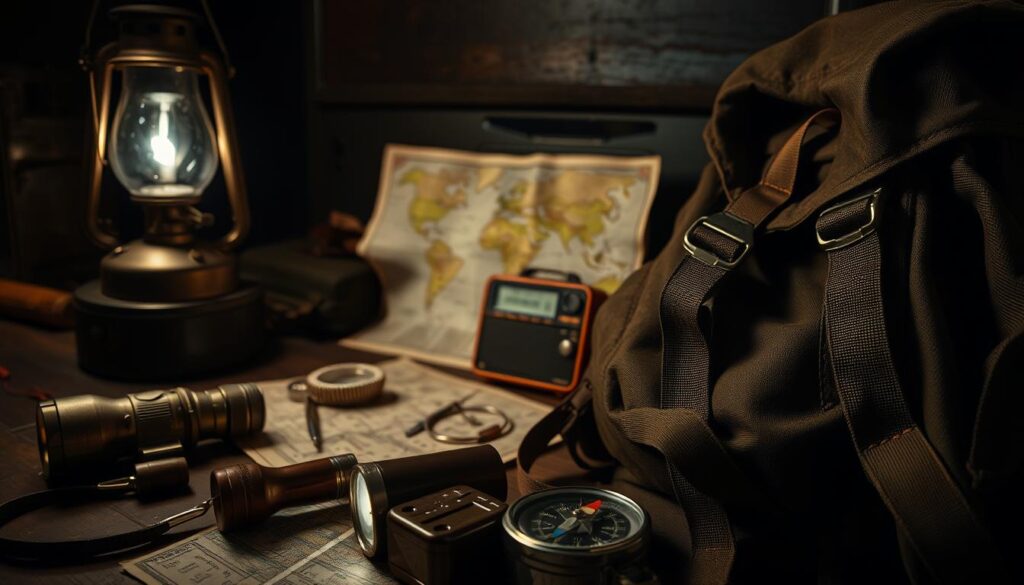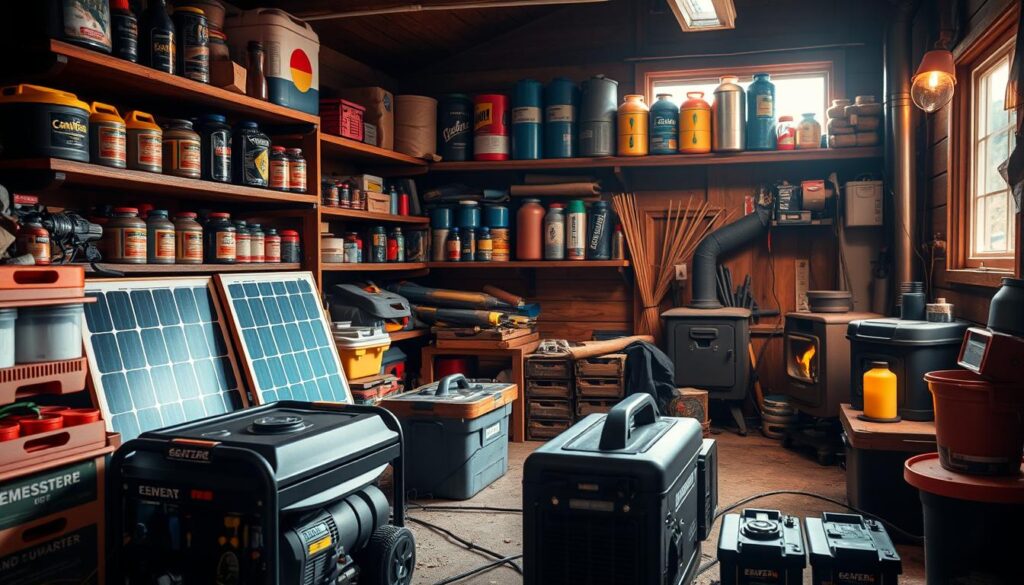I’ve always been drawn to the primitive fire starting method called the fire plough. It’s an ancient way to start fires without modern tools. You make friction between a stick and a wood groove.
Learning the fire plough is great for wilderness survival. It also connects us to our ancestors. This friction fire making is easy to learn for anyone.
Thinking back on my fire plough journey, I see its importance. It reminds us of the value of traditional skills in today’s world.
Key Takeaways
- Understanding the basics of the fire plough technique.
- Learning how to apply the primitive fire starting method in wilderness survival situations.
- Appreciating the simplicity and effectiveness of friction fire making.
- Recognizing the historical significance of the fire plough.
- Mastering the technique to enhance your outdoor skills.
What Is the Fire Plough and Its Purpose?
The fire plough is an old way to start fires. It has been used by many cultures worldwide. Today, it’s valued for its simplicity and how well it works.
Definition of the Fire Plough
The fire plough is a basic yet effective way to start fires. It uses friction between a stick and a groove in a fireboard. This creates hot dust that can turn into a flame. It’s a method based on friction.
Historical Background
Many cultures have used the fire plough to start fires without modern tools. It shows human creativity and ability to adapt. Over time, it has evolved and been improved by each generation.
How It Works
The fire plough works by rubbing a stick through a groove in a fireboard. This creates friction that makes hot dust. When this dust is in a tinder nest, it can light up into a flame. It takes patience, the right materials, and practice to get it right.
For more details on the fire plough, check out the Wikipedia page on Fire Plough. It gives a full look at the technique and its importance in history.
Essential Tools Needed for the Fire Plough
A fire plough is a basic way to start a fire in the wild. It needs the right materials and safety gear. The success of this method depends on the fireboard and plough materials.
Choosing the Right Materials
The fireboard is often made from softwood. This is because softwoods like pine or cedar are easy to groove and produce lots of dust. This dust helps create heat and an ember to start a fire.
The plough or stick is made from hardwood, like oak or maple. Hardwoods are strong and can handle the friction and pressure needed to start a fire.
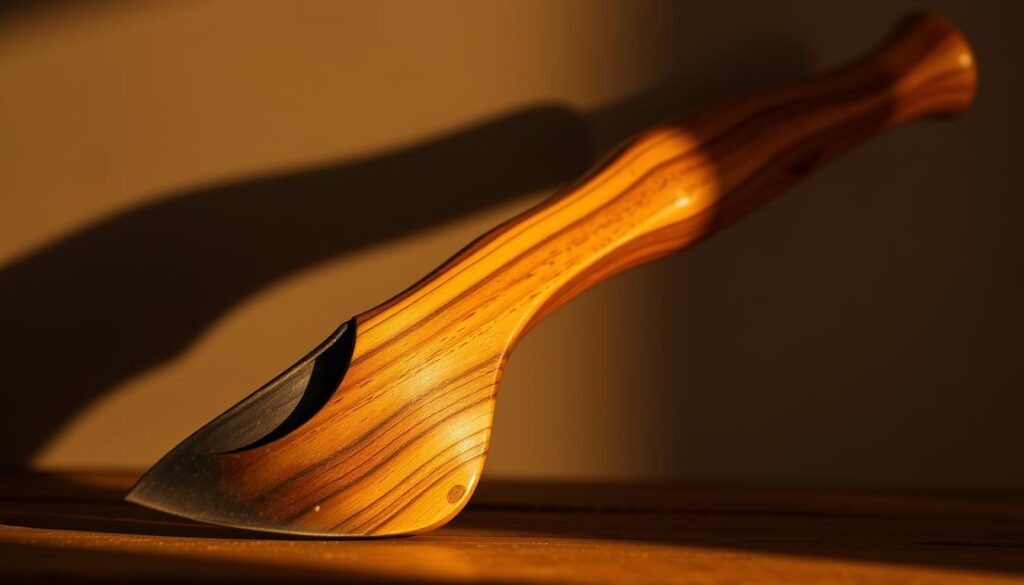
Safety Equipment Requirements
When using a fire plough, safety is key. You’ll need fire-resistant gloves to protect your hands, safety glasses to keep debris out of your eyes, and a fireproof mat or a clear area to start the fire. It’s also wise to have water or a fire extinguisher nearby to control the fire.
Choosing the right materials and safety gear also depends on the environment and weather. In dry or windy conditions, you need to be extra careful to prevent fires from spreading. Knowing the local fire starting and management rules is also important.
- Softwood for the fireboard (e.g., pine, cedar)
- Hardwood for the plough (e.g., oak, maple)
- Fire-resistant gloves
- Safety glasses
- Fireproof mat or cleared area
- Water or fire extinguisher for fire control
My Step-by-Step Guide to Using the Fire Plough
In this section, I’ll show you how to use a fire plough. It’s a simple tool for starting fires. With the right steps, you can learn it easily.
Preparations Before Starting
Before starting, prepare a tinder nest and choose the right kindling. Use dry leaves, grass, or small twigs for the tinder nest. Pick slightly larger sticks for the kindling to help grow the fire.
- Choose dry and fluffy tinder materials.
- Select kindling sticks that are slightly larger than the tinder.
- Ensure that both the tinder and kindling are dry and free from moisture.
Executing the Technique
To use the fire plough, start by making a groove in a piece of wood, called the fireboard. Then, use another stick, called the plough, to rub on the fireboard. Start slow and get faster as the rubbing makes heat.
- Create a groove in the fireboard.
- Hold the plough at a 30-degree angle and start applying gentle pressure.
- Increase the speed and pressure as the friction generates heat.
Common Mistakes to Avoid
When using a fire plough, don’t apply too little pressure, use the wrong materials, or hold it at the wrong angle. To avoid these, make sure your tinder and kindling are dry. Also, use the right technique.
Key takeaways:
- Apply sufficient pressure to generate heat.
- Use dry and fluffy tinder materials.
- Maintain the correct angle with the plough.
Benefits of Using the Fire Plough
The fire plough is a valuable tool for land management. It offers several benefits. When used correctly, it can clear land with minimal environmental impact.
Environmental Impact
The fire plough has a low environmental footprint. It’s better than mechanical or chemical methods. It allows for a natural process, reducing soil erosion and ecosystem damage.
Using a fire plough helps maintain the environment’s natural balance. It helps achieve land management goals without harming the ecosystem.
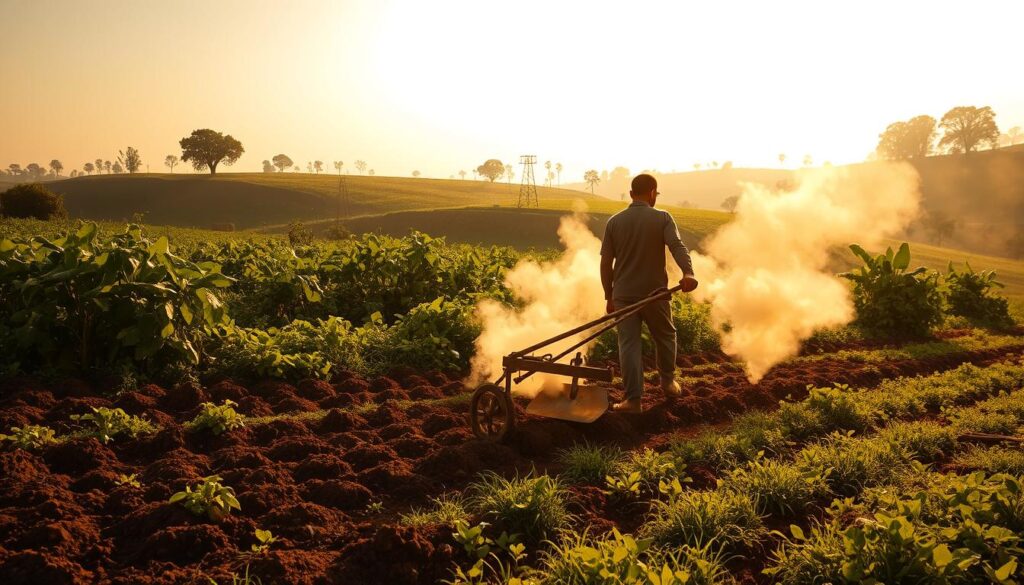
Efficiency in Clearing Land
The fire plough is efficient for clearing dense vegetation. It quickly removes unwanted plants. This promotes healthy regrowth and lowers wildfire risks.
Land managers can achieve their goals easily with a fire plough. It saves effort and resources.
In conclusion, the fire plough is great for land management. It has benefits like low environmental impact and efficient clearing. Understanding these advantages helps make better land management choices.
Fire Plough vs. Other Land Clearing Techniques
Land clearing uses many techniques, each with its own good and bad points. The fire plough is one, known for starting fires through friction.
Comparison with Traditional Methods
Traditional methods include machines or chemicals. The fire plough is different, being more natural and gentle. It doesn’t harm the soil or wildlife like machines do.
Advantages Over Chemical Treatments
Chemicals can pollute water and soil. The fire plough avoids this by starting fires through friction. It’s better for the environment.
Compared to chemicals, the fire plough is safer and more natural. It clears land well without harming the environment.
Tips for Maintaining Your Fire Plough
Keeping your fire plough in top shape is key for its long life and effectiveness. A well-kept fire plough is a trusted ally in wilderness survival. It helps you start fires when you need them most.
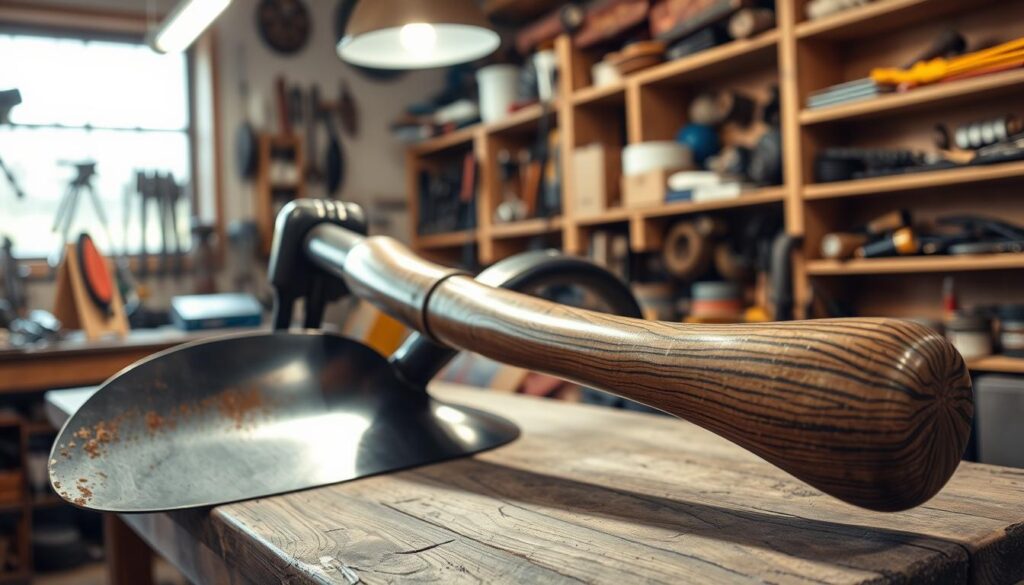
Cleaning After Use
It’s important to clean your fire plough after each use. Get rid of any dirt, debris, or residue. This keeps it in good working order and prevents damage.
Use a soft brush or cloth to clean it. Focus on the moving parts and areas where dirt tends to collect.
Seasonal Maintenance Checklist
Regular care is essential for your fire plough’s longevity. Here’s a simple checklist to follow:
- Check for wear or damage on the tool
- Apply lubricant to moving parts to prevent rust and ensure smooth operation
- Store the fire plough in a dry, protected area to prevent harsh weather damage
- Inspect the handle or grip for any signs of wear or damage
By sticking to this checklist, your fire plough will stay in great shape. It will be ready for you when you need it.
Understanding Fire Behavior in Relation to the Plough
Knowing how fire acts is key when using a fire plough. This traditional fire starter works by creating heat through friction. But, its success depends on things like soil and weather.
How Soil Type Affects Fire Spread
The soil type greatly affects fire spread with a fire plough. Dry, loose soil helps fires spread easily. But, damp or dense soil can slow it down. Knowing the soil is important for managing the fire.
Role of Weather Conditions
Weather conditions like temperature, humidity, and wind speed are very important. For example, strong winds can make fires spread fast. But, high humidity can slow them down. Knowing the weather is key for safe fire plough use.
By thinking about soil and weather, fire plough users can better control and predict fires. This makes the experience safer and more controlled.
Common Challenges Faced When Using a Fire Plough
The fire plough technique is effective but comes with challenges. I’ve used it for wilderness survival and know these challenges are key to starting a fire.
Dealing with Difficult Terrain
One big challenge is dealing with tough terrain. The fire plough’s success depends on the soil or ground. For example, very dry or sandy soil might not work well because it lacks friction. On the other hand, too damp or clay-heavy soil can be too sticky, making the plough get stuck.
To solve this, it’s important to pick the right terrain or adjust your method. For more tips on wilderness survival, check out Mastering the Fire Plough Method.
Here’s a look at different soil types and how well they work for fire ploughing:
| Soil Type | Friction Level | Suitability |
|---|---|---|
| Dry Sandy Soil | Low | Poor |
| Clay-heavy Soil | High | Moderate |
| Loamy Soil | Moderate | Good |
Managing Fire Intensity
Another challenge is managing the fire’s intensity once it starts. The fire plough can create a strong flame. If not controlled, it can spread too far. It’s important to start small and have a plan to keep the fire in check.
Knowing how to adjust your technique is key. For example, changing the angle and pressure of the plough can help control the ember generation.
In conclusion, the fire plough is a valuable tool for wilderness survival. But, knowing the challenges and how to overcome them is essential. By understanding the terrain and managing fire intensity, users can successfully use this method.
Case Studies: Successful Use of the Fire Plough
Using the fire plough has changed many lives, and I’m excited to share some stories. It’s a primitive fire starting method that works well in many outdoor situations. It’s a must-have for anyone who loves the outdoors.
Personal Experience Stories
On a camping trip, I used the fire plough to start a fire in a hard-to-reach area. It worked great, even when it was damp. It kept us warm and let us cook our food.
During a survival training, the fire starting technique saved the day. The fire plough kept our spirits up and kept us warm all night.
Examples from Other Users
Many outdoor lovers have shared their success with the fire plough. For example, a hiker used it to start a fire on a solo trip. It helped him stay warm and safe on a cold, wet night.
Researchers also used the fire plough in a study on starting fires the old way. They found it to be very efficient and reliable compared to other methods.
These stories show how good the fire plough is as a fire starting technique. It’s been a game-changer for survival and outdoor fun.
Future Trends in Fire Management Techniques
The fire plough is key in wilderness survival and friction fire making. New designs are coming that will make it better and safer.
Advancements in Design
New materials and tech are being tested to boost the fire plough’s performance. These changes aim to make it more durable and user-friendly, even in tough spots.
Ongoing Research
Scientists are studying how soil and weather impact the fire plough’s success. This study will lead to smarter fire management plans, using the fire plough method.
With these advancements and studies, we’re set for better and safer fire management. This will help us master friction fire making and wilderness survival with the fire plough.
FAQ
What is a fire plough?
A fire plough is an old tool for starting fires. It works by rubbing a stick against a wood groove. This creates hot dust that turns into a flame.
What materials are best for making a fire plough?
Softwoods are best for the fireboard because they’re easy to work with. They also make a lot of dust when rubbed. Hardwoods are better for the stick because they’re strong.
How do I prepare for using a fire plough?
First, get ready with tinder and kindling. Then, pick the right wood for the fireboard and stick.
What are common mistakes to avoid when using a fire plough?
Don’t make the mistake of not applying enough pressure. Also, make sure you have the right materials. And don’t forget to prepare tinder and kindling.
What are the benefits of using a fire plough for land clearing?
The fire plough is a green way to clear land. It’s better than chemicals and machines because it’s kinder to the environment.
How does the fire plough compare to other land clearing techniques?
The fire plough is gentler on the environment than chemicals and old methods. These can harm nature a lot.
How do I maintain my fire plough?
Clean it after each use. Also, follow a seasonal check-up list. This keeps your fire plough ready for when you need it.
What factors influence fire behavior when using a fire plough?
Soil and weather can change how fires spread and grow. Knowing this helps use the fire plough safely and well.
How can I overcome common challenges when using a fire plough?
To tackle tough spots, be prepared and have the right stuff. Also, understand how weather and soil affect fires.
What are some future trends in fire management techniques related to the fire plough?
New designs and research will make the fire plough better. It will get more efficient and useful.
Is the fire plough a reliable method for starting fires?
Yes, the fire plough is a dependable way to start fires. With practice and the right materials, it’s a great skill for the wild.

